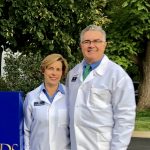Alumni Profile: Drs. Carolyn Romzick and David Clark, a double-dentist couple that thrives on the double duties of treating and teaching15 min read
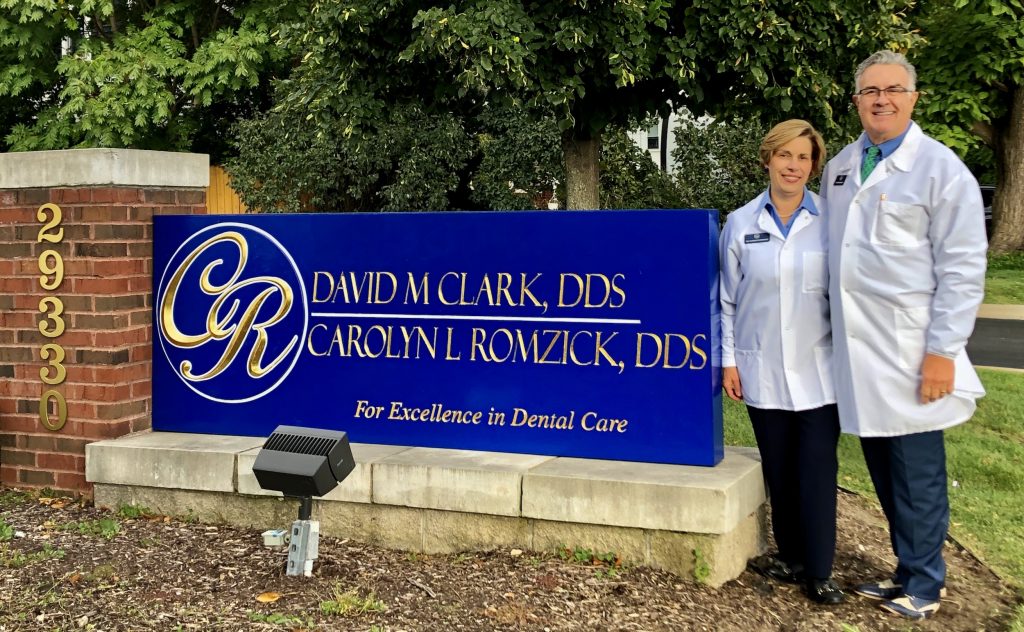
Carolyn Romzick and David Clark came up with a simple but fitting way to celebrate the 35th anniversary of their dental practice in July.
The married couple had started their practice from scratch in the Detroit suburb of Farmington Hills in 1984. They were young and independent, just out of the University of Michigan School of Dentistry, and wanted to practice together. They rejected the more common methods of getting started in dentistry. They didn’t join another dentist’s existing practice or buy the practice of a retiring dentist with a ready-made list of patients. Instead, they hung out their shingle and waited for patients.
“The only two patients we had were each other – and we were non-paying patients,” Carolyn noted recently as she mused about those early days.
Since today they have a thriving practice and have reached 35 years in the business, it means lots of patients eventually showed up and kept coming back. In a sentimental thank-you to someone who was there at the start, Drs. Romzick and Clark decided to celebrate the anniversary by inviting their first real patient, a woman named Cindy, to join them for lunch. She’s still a patient today, but during that lunch date on July 5, the exact anniversary of their first day in business, she was also symbolic of how success sometimes starts slowly.
Carolyn and David have fond memories and frequent laughs when they recall how they transitioned from being students at the dental school to teaching at the dental school to branching out into their practice. A constant in their story is the dental school, which is where they met and where Carolyn teaches today as a clinical adjunct associate professor two half-days a week. Their youngest child, Meredith Clark, will graduate next spring with her own DDS from U-M.
Carolyn and David each gained admission to the dental school after three years of undergraduate studies at U-M and U-M-Flint, respectively. They met the first week of dental school at a social event at the Delta Sigma Delta fraternity when she was a second-year student and he was a first-year student. They spent a lot of time on the school’s Honor Council – she was chair and he was vice-chair – which they credit with starting their personal relationship. They dated throughout dental school and were engaged shortly before she graduated in 1982. While David finished his fourth year, Carolyn went to a one-year General Practice Residency at the Wilmington Medical Center in Delaware. She returned in the summer of 1983 as David graduated with his DDS, and they were married that fall.
David was offered a post-graduation, part-time adjunct teaching position at the dental school in what was then the Operative Department. He needed a full-time job, so he queried other departments and was able to pair the first offer with a second half-time position in what was known as Crown and Bridge. Carolyn also got a full-time adjunct position in the Oral Diagnosis Department for a year, so they were employed while figuring out how to start their practice. They decided on Farmington Hills and found an office location and a willing banker. To make time for the fledgling practice, Carolyn scaled down to a part-time adjunct position in 1984 and David soon did the same. To supplement their meager income as they grew a patient base, David also worked Monday nights and Saturdays for a dentist in Livonia.
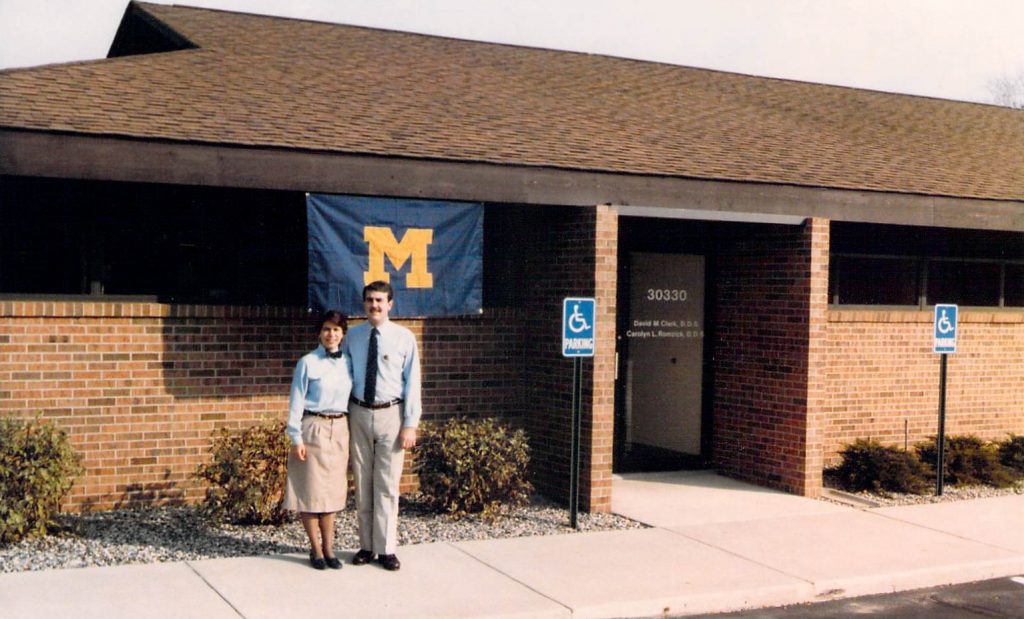
Carolyn remembers that period as “mayhem.” “We would work our practice in the morning, leave at lunchtime to drive to Ann Arbor, and we would teach the afternoon clinic at the dental school. Then we’d get back in the car. On Mondays I’d drop him in Livonia and he would work there in the evening while I would go back to our office. We took Tuesday nights off, but we’d work Wednesdays and Thursdays until 9 p.m.” David would work for the other dentist on Saturday, too, then starting the next week, they would repeat the weekly schedule “over and over again,” Carolyn said.
After the practice began to grow, David dropped his part-time teaching at the dental school in 1987; Carolyn continued her adjunct duties until 1988 when she was pregnant with their first child. Since they no longer had to drive to Ann Arbor during the week, things eased up a bit. Then in October 1988, a month before their baby was due, they learned that a nearby dentist was selling his long-established and successful practice. It was too good of an opportunity to pass up. Eight days before they became the proud parents of their son Andrew, they signed the purchase agreement and became the proud owners of a second practice and second office location. Suddenly, not only did they have a new baby, but they had a much larger schedule of patients and their employee roster increased from one – a receptionist at their first practice – to several hygienists and other staffers who had worked for the retiring dentist.
In the first weeks after Andrew was born, David went back and forth between the two offices in an exhausting attempt to keep up with the new patient load by himself. Eventually, when Carolyn returned to work, they created a schedule that combined office efficiency with time off for home duties. They quickly realized that they needed to merge the practice they had purchased into their original office. With patients, records and staff in only one location, things stabilized and they moved slowly toward a much more civilized day-to-day practice and family life. Their practice grew, their family grew – daughters Emily and Meredith arrived – and they became active in the local community, their church and various organizations.
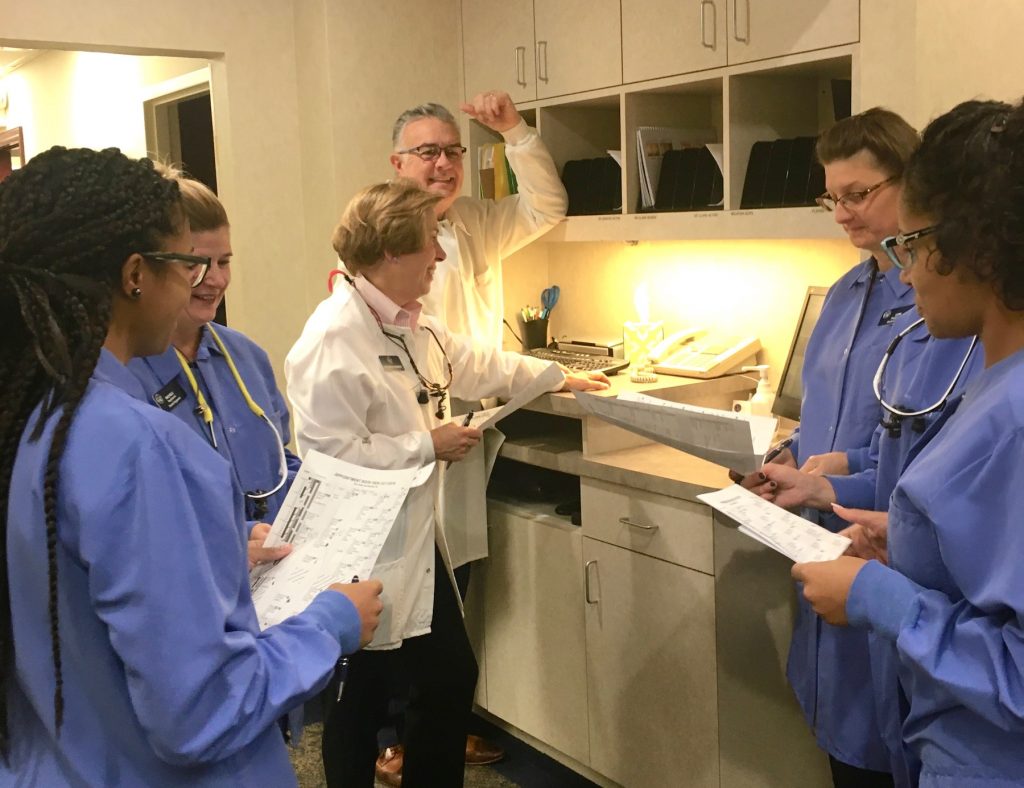
Today, their general practice dental care is delivered to patients in a building they built and moved into in 2005 near their original office. In 2013, after Meredith was at U-M for her undergraduate degree, Carolyn returned to the dental school as a part-time adjunct faculty member. In a repeat of those drives to Ann Arbor in the first years of their practice, she now gets up early two mornings a week and makes her way back to her alma mater to teach the latest generation of dental students. David also shares his dentistry knowledge as a member of the faculty for the St. Joseph Mercy Oakland Dental Residency Program, where he was named Attending Faculty Member of the Year by residents in his first year there. For both Carolyn and David, their patient care and teaching are the products of their dental school experiences. The difficulties they overcame strengthened them for what they’ve encountered in the profession in the last 35 years.
David decided on dentistry in high school when his path to becoming an Eagle Scout required that he pick a profession and research it. He chose to shadow his family dentist and decided during the experience that it was the career he would pursue. “I was one of the rare people who enjoyed dental school even though it was horrifically hard,” he said. “Almost everybody in my class hated it and thought it was the worst, most oppressive experience in the world. I felt like I was doing what I wanted to do and what I was called to do, and this was something I had to do to meet that goal. While I wouldn’t say the work was fun, my attitude about it was good.”
The combination of tough coursework and demanding professors, combined with his four years of work as an adjunct when he first graduated, prepared him for the complex cases that he says are his most gratifying work as a dentist. “I don’t get thrilled by what most people would call simple dentistry of a filling here and a filling there,” he said on a recent day. He had just finished a three-unit bridge on implants he had placed a few months before for a male patient. The patient is single and was worried about how missing teeth would affect his social life, among other concerns. “Helping somebody put together that corner of their mouth when it’s been vacant for a while is gratifying,” David said. “By being able to put teeth back in there, he can be more confident about going out and socializing and dating. How those things affect people in their personal life is gratifying. The more complicated the case, the better, as far as I am concerned.”
Carolyn’s dental school days started after she had an undergrad roommate at U-M who majored in dental hygiene. Seeing what her roommate studied, and tagging along to the dental school a few times, convinced her to follow the career choice of two uncles who were dentists. “It was tremendously difficult. I found it very hard,” she said of dental school. “The volume of work from the minute you walk in was challenging. You’ve got all these didactic courses and you’ve got all the clinical and skill development courses. But I liked what I was doing.”
Carolyn and David note the many changes in dentistry since they went through dental school – the ubiquitous latex gloves dentists now wear; the dozens of kinds of dental cement that have replaced what was once a single choice; the advanced surgeries and procedures such as dental implants. From her teaching position in the clinics, Carolyn helps direct students through many of the new procedures and materials, but she says she didn’t realize how much the classroom curriculum had changed over the years until Meredith started dental school. “When she became a first-year student, I saw what they were learning in their didactic courses with the hardcore science,” she said. “These things, like gene sequencing, hadn’t been discovered when we were in school. I saw her study sheets and I thought, I couldn’t do this. It is just so complex. So the education they are getting from that standpoint is phenomenal.”
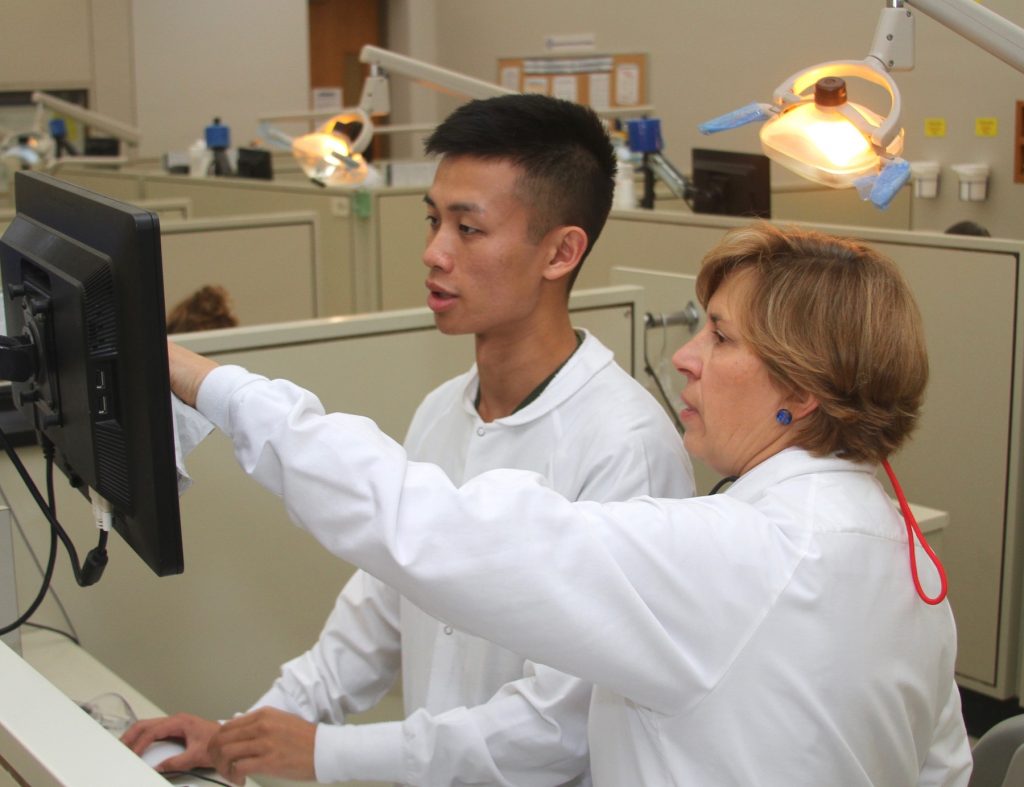
One thing that hasn’t changed, she said, is an emphasis on critical thinking. “I’ve always felt that the Michigan education gave you depth and breadth, enough so that you could become a good critical thinker,” Carolyn said. “Maybe you didn’t always know all the answers, but you knew exactly how to find the answers. And if you had problems with something, you knew how to troubleshoot it.”
David concedes that he, like most dentists, tends toward over-analysis and perfectionism. “Even when we do what we consider our best at the moment, we go back and review it and ask how could I have done this differently,” he says. “And if I had the chance to do it over, would I? If so, how would I make it better? I think that’s inherent in how we were trained.”
Carolyn demonstrated the continuing education aspects of dentistry in a unique way in 2016 when she decided to undergo an “orthodontic journey” as an adult. Getting braces became an educational experience not only for her as a veteran dentist but also for the rest of the world because she wrote a public blog during her 18-month course of treatment. “I’ve done some wild and crazy things in life but deciding to go through orthodontics as a 50-something dentist was never on my list of things to do … until about six months ago,” she wrote in her first post on Sept. 8, 2016. She and her dentist, i.e. David, had noticed in recent years that she was losing “bite stability” because of aging and years of clenching and grinding her teeth while sleeping. She approached a long-time colleague and friend Dr. Thomas Jusino (U-M DDS 1981, MS 1983). He refused to charge her for the orthodontia, so she returned the favor with an informative and entertaining first-person blog that documented the procedure in words and photographs. It’s a valuable primer for anyone considering braces, particularly for adults who might think braces are just for teens. On the day in February 2018 when she had the braces removed, she wrote exuberantly in the blog: “It has been exactly 77 weeks, 539 days and 12,936 hours since I was banded and wired for my orthodontic treatment … and I AM DONE!!!!! It is difficult to explain how good my teeth feel now that they are properly aligned. I entered into this project with the goal of improving my bite. Changes to the appearance of my smile were secondary, but all I can say is, WOW. My bite feels great and my teeth look fabulous!”
The braces decision and blog might feed the notion that “it’s all about dentistry” for the couple, but they do have some non-dentistry diversions. David loves fly-fishing in northern Michigan and singing with his church choir and the Plymouth Oratorio Society, which performs, as he puts it, “long-hair music,” by which he means the music of Handel, Mozart and Bach. Carolyn’s non-dentistry passion centers on exercise – early-morning workouts at the gym, swimming and running. She is a member of a local swim club and participates in U.S. Masters Swimming events a couple of times a year, frequently picking up medals in various strokes and distances up to a mile.
Ultimately, though, how can two dentists married to each other ever get very far away from their profession? “If you were to ask our three children whether we talked about dentistry at the dinner table as they were growing up, they would say that was all we ever talked about,” David said. “That’s not true but clearly they felt it was. Yes, it happens fairly frequently because it is such a big part of our lives.”
Meredith confirms the kids’ view of the dinner table conversation, though it’s probably not why son Andrew went into law and daughter Emily chose social work. For Meredith, the dentistry dialogue wasn’t all bad because she was the child who enjoyed tagging along with her parents to the office. “Growing up, I knew how to number the teeth by the time I was eight because at the dinner table all we talked about was teeth and my parents’ day and different things they were working on,” she remembers. Given that she eventually settled on dentistry, there were obvious advantages to being immersed in it. “I think the most significant thing I learned was how much of their job is not dentistry,” she said. She heard a lot about employees and employment issues, buying and maintaining many types of equipment for the office, and myriad regulations and the related paperwork. “All these things that you don’t think about when you are going to dental school because you think, ‘I’m going to work on teeth all day.’ So there’s this whole other aspect of owning your own practice. That was a huge thing I knew about before coming into dental school that a lot of my classmates didn’t.”
Meredith has a U.S. Army scholarship for dental school that will require a three-year commitment to the Army when she graduates. After that, the door is open to joining her parents’ practice. She says it would be foolish to not at least consider that option, but a lot can happen in three years in the Army. Carolyn and David are prepared for any outcome. “We keep investing in the practice and we keep doing what we need to do to keep it active, current, fresh, alive, vibrant,” Carolyn said. “Our patients ask about Meredith and we don’t have any answers, but the door is open and she would be welcome if she wanted to do that. She would be an asset, but no pressure on her, none at all.”
In the meantime, Carolyn and David will continue to focus their energies on their patients, and transfer as much of their knowledge and experience as they can to the dental students and residents they work with. It’s a satisfying life, David says. “Oddly enough, I still get gratification when I hear the office phone ringing because I know that somebody, somewhere, had to look up my name or Carolyn’s and they had to punch the phone numbers and wanted to call us. That feels good, still.”
###
The University of Michigan School of Dentistry is one of the nation’s leading dental schools engaged in oral health care education, research, patient care and community service. General dental care clinics and specialty clinics providing advanced treatment enable the school to offer dental services and programs to patients throughout Michigan. Classroom and clinic instruction prepare future dentists, dental specialists and dental hygienists for practice in private offices, hospitals, academia and public agencies. Research seeks to discover and apply new knowledge that can help patients worldwide. For more information about the School of Dentistry, visit us on the Web at: www.dent.umich.edu. Contact: Lynn Monson, associate director of communications, at [email protected], or (734) 615-1971.

